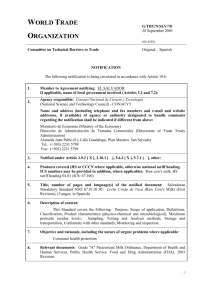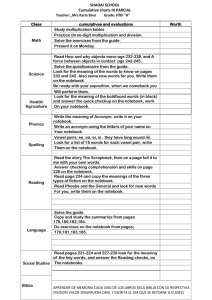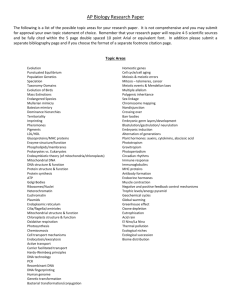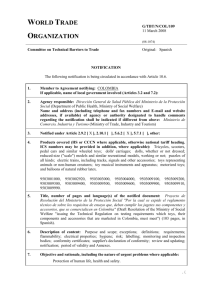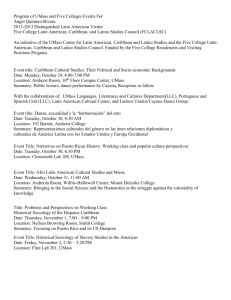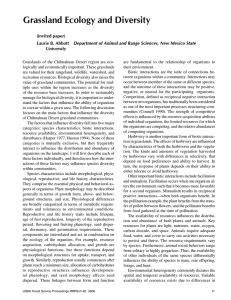6th Grade 1st Bimonthly School Year 2014
advertisement
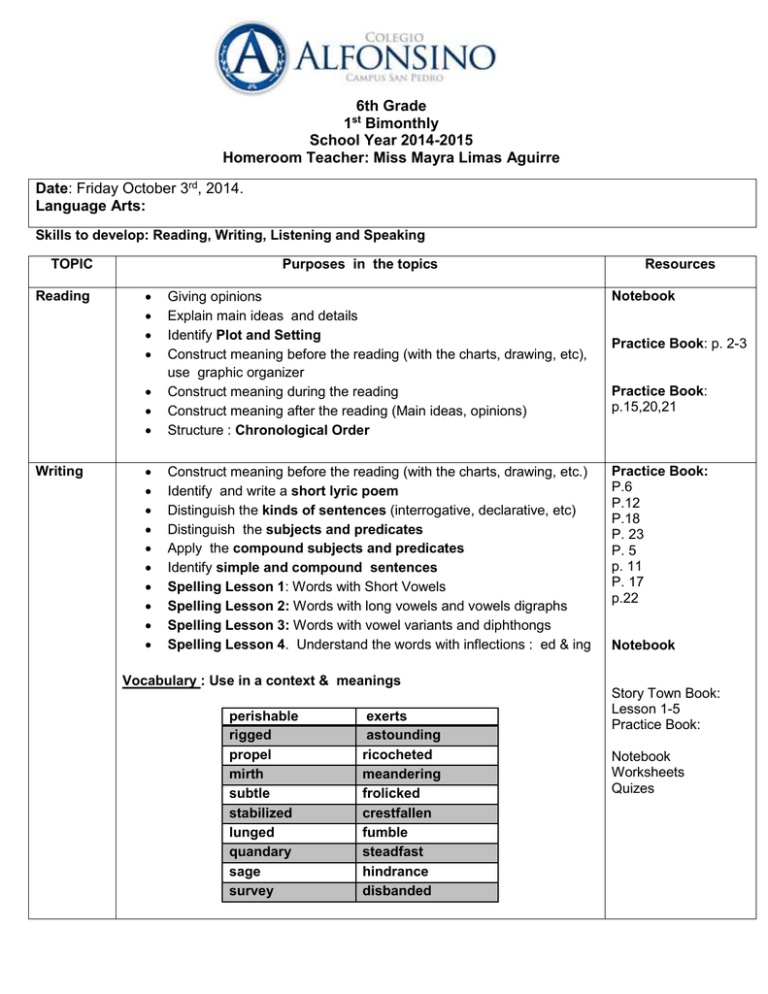
6th Grade 1st Bimonthly School Year 2014-2015 Homeroom Teacher: Miss Mayra Limas Aguirre Date: Friday October 3rd, 2014. Language Arts: Skills to develop: Reading, Writing, Listening and Speaking TOPIC Reading Writing Purposes in the topics Resources Notebook Giving opinions Explain main ideas and details Identify Plot and Setting Construct meaning before the reading (with the charts, drawing, etc), use graphic organizer Construct meaning during the reading Construct meaning after the reading (Main ideas, opinions) Structure : Chronological Order Construct meaning before the reading (with the charts, drawing, etc.) Identify and write a short lyric poem Distinguish the kinds of sentences (interrogative, declarative, etc) Distinguish the subjects and predicates Apply the compound subjects and predicates Identify simple and compound sentences Spelling Lesson 1: Words with Short Vowels Spelling Lesson 2: Words with long vowels and vowels digraphs Spelling Lesson 3: Words with vowel variants and diphthongs Spelling Lesson 4. Understand the words with inflections : ed & ing Practice Book: P.6 P.12 P.18 P. 23 P. 5 p. 11 P. 17 p.22 Vocabulary : Use in a context & meanings perishable rigged propel mirth subtle stabilized lunged quandary sage survey exerts astounding ricocheted meandering frolicked crestfallen fumble steadfast hindrance disbanded Practice Book: p. 2-3 Practice Book: p.15,20,21 Notebook Story Town Book: Lesson 1-5 Practice Book: Notebook Worksheets Quizes Listening Speaking (Oral exam) Paraphrase and summarize information and ideas to focus or clarify understanding Summarize and explain and ideas from oral text , citing important details. Infer information when they listen any kind of text. Give information about the reading when they listen stories. Clarify thinking through the dialogue Use the speaking to present information to a group. Topic : 1.- Speak about the time when you felt embarrassed. Where you were and what happened. 2.-Speak about someone who has helped you achieve a goal in your life. What your goal was and how she/he helped you. 3.-Speak about someone you admire because his/her special talents or abilities. What you admire of that person and why. 4.-Speak about an invention that you would like to design for helping people. Describe its function and characteristics and how it would help people in the future. Skills: Task Completion, Interpersonal Communicative, Vocabulary, Grammar, Comprehensibility and fluency Notebook The students will get one of the topics given and they will speak 1 minute about it (they can not memorize it they have to speak and explain in their own words) Date: Monday October 6th, 2014 Math TOPIC THEME PURPOSES Solve real life word problems involving addition, subtraction, multiplication and division. Understanding of Place Value in whole numbers and decimals. Compare decimals and using number lines and shapes with appropriate increments. Compare and order fractions by using circles, number lines, etc. Represent the relationship between decimals and whole numbers using base-ten materials. Estimating when solving problems involving addition , multiplication, subtraction, and division. Read and write whole numbers up to 1,000,000. Use a standard order to solve problems (PEMDAS) when performing a series of operations. RESOURCES Notebook Student’s book pages: 5, 6, 7, 27, 28, 31, 32, 33, 35, 36, 37, 39, 40, 41 Student´s book: 27 Student´s book p.29 Date: Tuesday October 7th, 2014 Science TOPIC THEME PURPOSES Plant and Animal Kingdoms Compare organisms within the plant or animal kingdoms: basic needs, similarities and differences, classification, etc. Compare and contrast characteristics of organisms within the plant kingdom (coniferous and deciduous trees, ferns and flowering plants) Compare and contrast characteristics of organisms within the animal kingdom (fish and mammals; birds and insects; reptiles and crustaceous) Biodiversity Demonstrate an understanding of biodiversity as a variety within each species of plants and animal Demonstrate an understanding of biodiversity as a variety among species of plants and animals communities Demonstrate an understanding of biodiversity as a variety among species of plants and animals communities and the physical landscapes that support them. Biodiversity within and among communities Describe how to maintain the resilience of the species Explain the ways in which biodiversity within and among communities is important to maintain the resilience of these communities Describe interrelationship within species, between species and between species and the environment. Analyze and explain about the organism found in a specific habitat and determine their relevance for human survival. RESOURCES Notebook Quizzes Date: Tuesday, October 7th, 2014. Health TOPIC Stage of growth Purposes in the topics Resources Describe physical social-emotional and interpersonal changes in Notebook adolescence to determine how they impact behaviors, communication, and quizzes decision making and physical change. Identify some infection disease transmission, including AIDS, the ways to prevent infectious diseases, demonstrate knowledge of allergies and describe the short-and-long terms effect of illicit drugs. Identify health related terms such as: proper nutrition, hygiene, rest, infection disease prevention, healthy habits, personal hygiene, harmful substances etc. Identify factors that enhance healthy relationships with friends, family and peers, the responsibilities associated with caring themselves, the strategies to deal positively with stress and pressure from relationships with family and friends and the importance of helping others in community. Describe the interrelationship of emotional, intellectual, physical and social health in adolescence, and indentify emotional changes. Date: Wednesday 8th, 2014 Español TOPIC Lectura Escritura Escucha Valor: 75% Purposes in the topics Explicar las características de los relatos históricos. Identificar y explicar la función de las distintas partes de un texto (introducción, desarrollo y conclusión). p. 103 y libreta p. 110-111 y libreta Uso de adverbios y adjetivos. Identificar verbos en pretérito y copretérito. Comparar y contrastar una biografía y una autobiografía. Uso de oraciones yuxtapuestas, coordinadas y subordinadas de manera adecuada. Identificar las funciones de las personas que hacen un programa de radio. Ortografía de palabras con “b y v”. Exponer su programa de radio (equipos) Representar el guion radiofónico en mínimo 5 minutos. . Expresión Oral Fecha de exposición: jueves 2 de octubre 2014. Valor: 25% Resources p. 103-104 y libreta p. 109 y libreta p. 27- 30 y libreta p. 32 -33 y libreta p. 39- 43 y libreta Libreta Date: Wednesday October 8th, 2014. Deutsch TOPIC Freizeit Purposes in the topics Be able to use local preposition: zu + dativ and in + accusative answering to the question wohin …? Temporal prepositions vor and nach + dativ answering to the question Wann…? Express frequency ( immer, einmal pro Woche….) answering to the question wie oft….? Resources Deutsch.com Kursbuch Pg.48-53 Deutsch.comArbeitsbuch Pg.54-59 Date: Thursday October 9th, 2014 Sociales TOPIC Cívica Historia Proposes in the topics Distinguir los cambios físicos en el cuerpo y modo de pensar. Entender que hay diversidad de ideas. Entender y explicar la equidad de género. Identificar los hechos que afectan la salud y dignidad de la persona. Explica cómo fue la evolución de los seres humanos. Compara y contrasta al homo habilis, homo erectus, homo sapiens y homo sapiens-sapiens. Entender como el ser humano se dispersó por todo el mundo y el entorno que lo rodeaba. Compara y contrasta entre el hombre prehistórico nómada y sedentario (alimentación, vivienda, vestimenta, herramientas). Sintetizar como fue la prehistoria en América. Geografía Entender las características de las regiones continentales. Entender lo que son los territorios y sus escalas. Explicar, contrastar y comparar los planos urbanos y mapas temáticos. Definir lo que es la tecnología de información. geográfica. Resources Todos los temas serán estudiados de la p. 14- 40 y de la libreta. Todos los temas serán estudiados de la p. 12- 25 y de la libreta. Libro p. 11 – 16 y libreta Libro p. 20-23 y libreta Libro p. 28-30 y libreta. Libro p. 34- 36 y libreta Date : Thursday October 9th,2014. Technology & Applications. Complete Guide SESWEB Date: Friday October 10th, 2014 Sociales TOPIC Cívica Historia Proposes in the topics Distinguir los cambios físicos en el cuerpo y modo de pensar. Entender que hay diversidad de ideas. Entender y explicar la equidad de género. Identificar los hechos que afectan la salud y dignidad de la persona. Todos los temas serán estudiados de la Explica cómo fue la evolución de los seres humanos. Compara y contrasta al homo habilis, homo erectus, homo sapiens y homo sapiens-sapiens. Entender como el ser humano se dispersó por todo el mundo y el entorno que lo rodeaba. Compara y contrasta entre el hombre prehistórico nómada y sedentario (alimentación, vivienda, vestimenta, herramientas). Sintetizar como fue la prehistoria en América. Entender las características de las regiones continentales. Entender lo que son los territorios y sus escalas. Explicar, contrastar y comparar los planos urbanos y mapas temáticos. Definir lo que es la tecnología de información. Geográfica. Todos los temas serán estudiados de la Geografía Resources p. 14- 40 y de la libreta. p. 12- 25 y de la libreta. Libro p. 11 – 16 y libreta Libro p. 20-23 y libreta Libro p. 28-30 y libreta. Libro p. 34- 36 y libreta Date: Tuesday October 7th,2014 Social Studies TOPIC Purposes in the topics Resources Roman society influence in modern societies Characteristic of Roman society Notebook Implications of Roman society on modern societies Goverments Organization Identify historical origins of democratic forms of government Quizzes Describe the influence of Roman and Greek societies in occidental modern societies Compare governmental structures Compare economic systems Characteristics and relative location of major historical and contemporanny societies Locate major historical contemporary societies on maps and globes comparing them of economy and government. Identify Geographic factors responsible for patterns of population in places and regions including demographics. Influential Events Understand how historical wars influenced countries boundaries.

